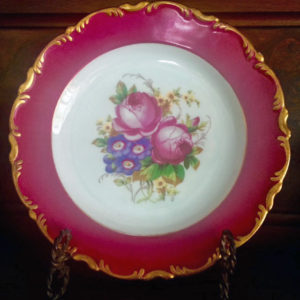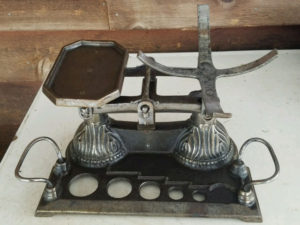by Lisa C. Cantwell
Dear Reader: This is a column to help you determine the history and value of your heirlooms, attic finds, flea market purchases, or antique items. Please send a picture and description of your piece, such as how you acquired it and any details about its history, to tomandlisa@wildblue.net. I’ll research any item, whether it’s a piece of furniture, a painting, a tool, a doll, a figurine, or an article of clothing. An approximate value will be determined to inform you if it’s a “Trinket or Treasure.” Please submit all pictures and questions by the preceding 15th of the month for possible publication in the next monthly issue of The Catoctin Banner. All inquiries will be answered; however, only those selected for publication will include approximate value assessments. Furthermore, not all submissions may be published in the Banner due to space considerations. Please include your name or initials and where you reside. Thank you and happy treasure hunting!
“In 1995, we bought two of these plates at an estate sale in Beacon Falls, Connecticut. They were displayed on a mantle in this huge mansion that had been abandoned years before. A couple bought the house and sold most of its contents. We’ve always wondered where the plates were made and what they might be worth.”
— Jack and Holly O., Cascade, MD
Your plates are porcelain TREASURES and were made by Pirkenhammer, in what is now the Czech Republic.
 The emblem on the backs of these plates, depicting crossed hammers and a crown, dates them between 1918 and 1939. This fine porcelain was first produced in Pirkenhammer, Bohemia, in 1803. During the 1830s, it was considered the best dining ware made and was very popular with royalty throughout Europe. In 1915, a beautiful floral pattern, gilded in gold with a navy background, was created for Pope Benedict XV. Searches of this particular pattern, numbered “4812,” yielded little, but a similar, older pattern was priced at $41.00 per plate on a popular bidding site. Expect this porcelain to value over time, but currently a reasonable price would be $20 to $30 per plate.
The emblem on the backs of these plates, depicting crossed hammers and a crown, dates them between 1918 and 1939. This fine porcelain was first produced in Pirkenhammer, Bohemia, in 1803. During the 1830s, it was considered the best dining ware made and was very popular with royalty throughout Europe. In 1915, a beautiful floral pattern, gilded in gold with a navy background, was created for Pope Benedict XV. Searches of this particular pattern, numbered “4812,” yielded little, but a similar, older pattern was priced at $41.00 per plate on a popular bidding site. Expect this porcelain to value over time, but currently a reasonable price would be $20 to $30 per plate.
“I purchased this scale ten years ago at a yard sale in New Oxford, Pennsylvania. I never took the time to research it, but thought it was used to weigh nuts, bolts, and nails at a hardware store, or maybe even seed corn or beans? I date it to the late 1800s or early 1900s. What can you tell me about it?”
— T. Stover, New Oxford, PA
This is definitely a TREASURE, the research of which was quite challenging.
 Your scale appears to be composed of metal with an iron base. It appears to have all but one of its weights. The original “bowl” that would’ve fit on the exposed four prongs is missing. A search of late 19th century English and European scales revealed two with handles and a swirl design on the bases, similar to yours, but there were no identifying marks. The photo of the “WB” etched on your scale suggests that it could be a WB Scott scale, which was a manufacturer in the USA at the turn of the last century. However, none of the Scott scales resemble this piece. The scale was most likely used in a store for candy, jewelry, or hardware items. Although it’s very fancy for a “general store,” it might have been used to weigh sacks of seeds. Your scale is in excellent condition. Based on its age and design, expect to get $175 to $250.
Your scale appears to be composed of metal with an iron base. It appears to have all but one of its weights. The original “bowl” that would’ve fit on the exposed four prongs is missing. A search of late 19th century English and European scales revealed two with handles and a swirl design on the bases, similar to yours, but there were no identifying marks. The photo of the “WB” etched on your scale suggests that it could be a WB Scott scale, which was a manufacturer in the USA at the turn of the last century. However, none of the Scott scales resemble this piece. The scale was most likely used in a store for candy, jewelry, or hardware items. Although it’s very fancy for a “general store,” it might have been used to weigh sacks of seeds. Your scale is in excellent condition. Based on its age and design, expect to get $175 to $250.
Victorian Glass Easter Egg
Keep an eye out this month in antique malls and flea markets for charming, old Easter eggs, made of paper mache,’ metal, clay, porcelain, and glass. Pictured (right) is one typical of blown, hand-painted eggs, found in homes during the late 19th and early 20th century. This particular egg dates from the 1920s, and its design is fading due to the fact that water colors were commonly used to decorate these eggs. Collectors aren’t too concerned about the condition of the decoration on the eggs, as a little distressing adds to the charm! This one measures 6 inches long and is 11 inches in circumference. These opaque eggs are holding their value and range from $15.00 to $45.00, depending on the size and condition. Consider a basket of them as a centerpiece at Easter dinner. Happy egg hunting!

